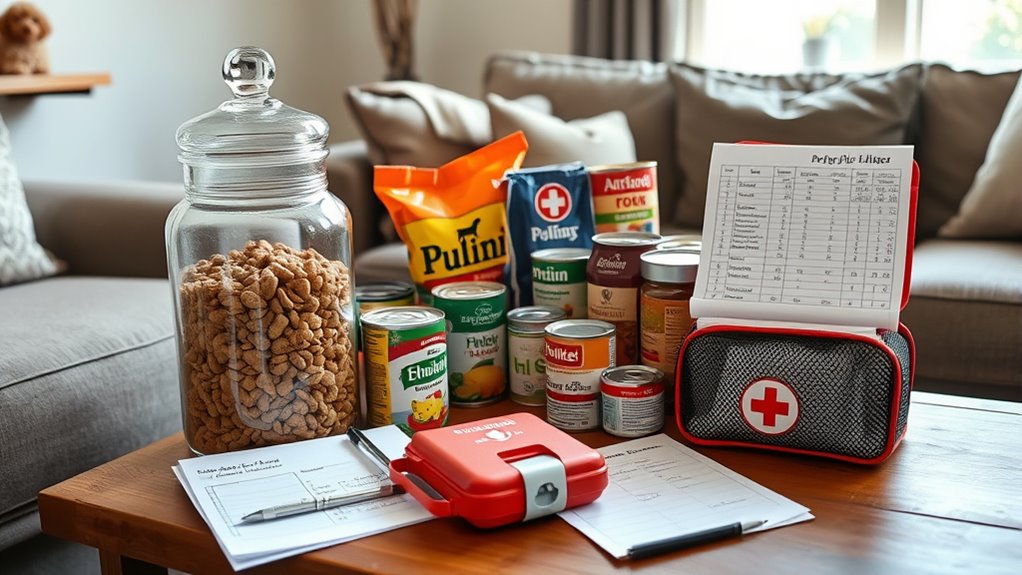To budget effectively for your pet, start by estimating monthly food costs based on your pet’s size and needs, and track expenses to plan ahead. Set aside funds for routine veterinary visits and vaccinations, and consider pet insurance or wellness plans to reduce unexpected costs. Keep an emergency fund ready for urgent situations, and learn basic pet first aid. Staying organized and proactive will help you manage expenses confidently—continue with us to discover more helpful strategies.
Key Takeaways
- Track monthly pet food and veterinary expenses to inform your overall budget.
- Set aside an emergency fund for unexpected health issues or urgent care needs.
- Use preventive care and regular vet visits to reduce long-term health costs.
- Consider pet insurance or wellness plans to offset costly veterinary bills.
- Maintain organized records of expenses and health history to plan future financial needs.
Estimating and Planning Pet Food Expenses

Have you ever wondered how much you’ll need to spend on your pet’s food each month? To plan effectively, start by figuring out your pet’s daily nutritional needs based on their age, size, and activity level. Check the food packaging for recommended serving sizes and calculate how much they’ll eat in a day. Multiply that by 30 to get a monthly estimate. Remember, some pets prefer specific brands, which can vary in price. Consider whether you’ll buy premium or generic options and how often you’ll need to restock. Keep track of your expenses over a few months to get a realistic idea of your pet’s food costs. This way, you’ll be better prepared to budget consistently and avoid surprises.
Managing Veterinary Costs Effectively

Managing veterinary costs effectively requires proactive planning and regular care to prevent expensive emergencies. Schedule routine check-ups and vaccinations to catch health issues early, reducing costly treatments later. Keep track of your pet’s medical history and note any changes in behavior or health, so you can address problems promptly. Consider investing in a wellness plan or pet insurance to offset unexpected expenses. Establish a dedicated savings fund for veterinary costs, so surprises don’t derail your budget. Choose a trusted veterinarian who provides transparent pricing and advice. Avoid skipping or delaying needed care, as this often leads to more severe and costly issues. Staying aware of health risks and early detection can prevent costly treatments and keep your pet healthier longer. Being attentive to signs of illness helps you intervene early, saving money and reducing discomfort for your pet. Additionally, understanding dog breeds and their specific needs can help tailor your veterinary care to your pet’s unique requirements. Recognizing common health issues early enables prompt treatment, further reducing potential costs. By staying consistent with preventive care, you save money and ensure your pet stays healthier longer.
Preparing for Unexpected Pet Emergencies

Are you prepared for the unexpected emergencies that can suddenly arise with your pet? Emergencies like injuries, sudden illness, or accidental poisoning can happen anytime. To stay ready, set aside an emergency fund specifically for these situations. Keep important documents, such as medical records and vet contact info, accessible. Learn basic first aid skills for pets, and know the signs of serious health issues. Have a list of nearby emergency clinics and their contact details. Regularly check your pet’s health to catch problems early. AI-driven diagnostics can help identify health issues before they become critical. By planning ahead, you’ll reduce panic during a crisis and ensure your pet gets prompt care. Preparing for emergencies isn’t just responsible; it can make a critical difference in your pet’s recovery.
Frequently Asked Questions
How Can I Find Affordable Pet Insurance Options?
You can find affordable pet insurance options by comparing plans online and reading reviews. Look for coverage that fits your budget and your pet’s needs, focusing on essential benefits. Consider policies with deductibles and co-pays that work for you. Don’t hesitate to ask your veterinarian for recommendations or check if local pet associations offer discounts. Shopping around guarantees you get good coverage without overspending.
Are There Budget-Friendly Alternatives to High-Quality Pet Food?
Did you know that nearly 70% of pet owners seek affordable alternatives to high-quality pet food? You can save money by switching to store brands or buying in bulk, which often offers discounts. Look for sales, coupons, or subscribe-and-save options. Preparing homemade meals, with vet-approved ingredients, can also cut costs while ensuring your pet gets nutritious food. These strategies help keep your pet healthy without breaking the bank.
What’s the Best Way to Track Pet-Related Expenses?
Tracking your pet-related expenses helps you stay on top of costs and avoid surprises. You should start by creating a dedicated budget folder or digital spreadsheet where you record every expense—food, vet visits, supplies, and emergencies. Use apps or budgeting tools to set reminders and categorize spending. Regularly review your records to identify areas where you can cut costs or adjust your budget, ensuring your pet’s needs are met without overspending.
How Do I Prioritize Pet Expenses During Financial Hardship?
When facing financial hardship, you need to prioritize your pet’s essential needs first. Focus on covering their food, basic medical care, and emergency needs. Cut back on non-urgent expenses, like toys or grooming. Look for affordable vet clinics or assistance programs if necessary. Remember, your pet’s health and safety come first, so make sure those are secured before spending on extras or luxuries.
Can I Set Aside an Emergency Fund Specifically for Pet Needs?
Absolutely, setting aside an emergency fund for your pet is a smart move. You can start by dedicating a small, consistent amount from your income each month. Keep this fund in a separate account to avoid spending it unintentionally. This way, when unexpected vet bills or emergencies arise, you’ll have the financial cushion you need without stressing your budget. It’s a proactive step to protect your pet and your finances.
Conclusion
By budgeting carefully for food, vet visits, and emergencies, you guarantee your pet’s health and happiness. Planning ahead might seem intimidating, but it’s key to avoiding unexpected financial stress. Are you ready to take control of your pet’s well-being and protect them from surprises? With thoughtful preparation, you’ll enjoy peace of mind knowing your furry friend is truly cared for, no matter what life throws your way.









